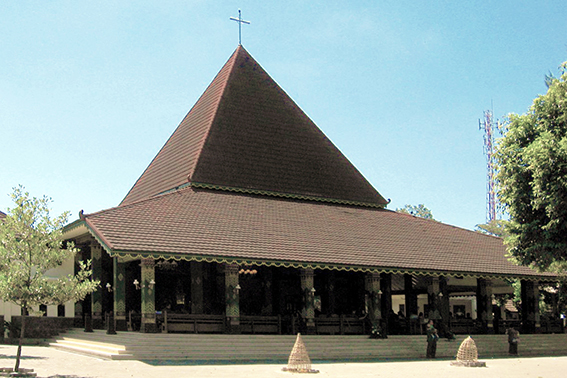Multi-Religious and Cultural Regionalism Integrated to Contemporary Sacred Church Buildings in Indonesia
DOI:
https://doi.org/10.17979/aarc.2022.9.0.9344Keywords:
Syncretic Ideas-Forms, Indonesian Church Architecture, Pre-Islamic and Islamic Java, Regionalism, Collective MemoryAbstract
Indonesia demonstrates a variety of cultural expressions through foreign contacts but has never adopted other cultures fully. The country blended significant components into local circumstances to create a distinctive culture with geographic variations, and its history must be understood in its terms. The design of Maclaine Pont (1936)’s Pohsarang Church combined Hindu-Buddhist elements into a Western building. Blimbingsari stone-wooden Church destroyed by an earthquake (1976) was rebuilt in the Balinese pavilion style with a running water garden. Similarities showed in Batak Karo architecture in Berastagi’s St. Francis Assisi, and Joglo architecture in Ganjuran Church where Jesus is depicted as a Javanese King. This exceptional regional phenomenon was due to integrating tradition, ethnicity, geographical space, and belief in multicultural societies. This paper discusses a few contemporary churches in Indonesia by historical contexts.
Downloads
Metrics
Publication Facts
Reviewer profiles N/A
Author statements
Indexed in
-
—
- Academic society
- N/A
- Publisher
- Universidade da Coruña
References
Aritonang, Jan S and Karel Steenbrink. (eds.) 2008. A History of Christianity in Indonesia. Studies in Christian Mission. Vol. 35. Leiden and Boston: Brill.
Assmann, J. 2008. «Communicative and Cultural Memory». In Cultural Memory Studies: an International and Interdisciplinary Handbook, edited by A. Erll and A. Nünning, 109–118. Berlin: De Gruyter.
Boelaars OFM Cap, J.W.M. Huub. 2005. Indonesianisasi, dari Gereja Katolik di Indonesia Menjadi Gereja Katolik Indonesia [Indonesianization, from the Catholic Church in Indonesia to the Indonesian Catholic Church]. Yogyakarta: Penerbit Kanisius.
Bosch, F.D.K. 1960. The Golden Germ: an Introduction to India Symbolism. The Hague: Mouton and Co.
Bosch, F.D.K. 1961. «The Problems of the Hindu Colonisation of Indonesia». In Selected Studies in Indonesian Archaeology. The Hague: Martinus Nijhoff, 1-12.
Connerton, Paul. 1989. How Societies Remember. Cambridge: Cambridge University Press.
Curtis, William J.R. 1985. «Regionalism in Architecture. Session III». In Regionalism in Architecture, edited by Robert Powel. Singapore: Concept Media/The Aga Khan Award for Architecture.
de Jong, Ursula and Flavia Marcello. 2019. «Stewardship and Renewal of Catholic Places of Worship in Australia». Actas de Arquitectura Religiosa Contemporánea 6: 156-171. Accessed August 10, 2021, https://doi.org/10.17979/aarc.2019.6.0.6236
Durkheim, Emile. 1995 (1912). The Elementary Forms of the Religious Life. Washington DC: Free Press.
Fontein, Jan. 1990. The Sculpture of Indonesia. Washington: National Gallery of Art.
Gedi, Noa and Yigal Elam. 1996. «Collective Memory - What is it?». History and Memory. Indiana University Press. 8-1: 30-50.
Geertz, Clifford. 1973. The Interpretation of Cultures. New York: Basic Books.
Guide of the World. 2022. «Republic of Indonesia Map». Accessed July 15, 2022. https://bit.ly/3ORIHh5
Gunawan, Undi. 2012. «Architecture as Embodied Culture; the Traditional as a Cultural Body in Ganjuran Church, Yogyakarta». Proceedings of ICKCS 2012: 56-60. Accessed September 9, 2021, https://bit.ly/3zQA9mk
Gupta, Shakti M. 1996. Plants in Indian Temple Art. Delhi: B.R. Publishing Corp.
Hakoköngäs, Eemeli. 2017. «Visual Collective Memory. A Social Representations Approach». PhD diss., University of Helsinki.
Halbwachs, Maurice. 1992 (1925). On Collective Memory. Chicago/London: University of Chicago Press/Francis Griffiths and Rizzoli.
Hardawiryana SJ, Robert. 2001. «Orientasi Seluruh Refleksi Teologis Pastoral tentang Proses Pemribumian Iman Kristiani di Nusantara». In Umat Kristiani Mempribumi Menghayati Iman Kristiani di Nusantara [«The Orientation of All Pastoral Theological Reflections on the Process of Indigenizing the Christian Faith in the Archipelago». In Indigenous Christians Living the Christian Faith in the Archipelago]. Yogyakarta: Penerbit Kanisius.
Holt, Claire. 1967. Art in Indonesia. Continuities and Changes. Ithaca, New York: Cornell University Press.
Jung, Carl. 1916 (1912). Psychology of the Unconscious. London: Kegan Paul Trench Trubner.
Kempers, Bernet A.J. 1937. Cultural Relations between India and Java. Calcutta: Calcutta University.
Kilde, Jeanne Halgren. 2017. «Protestant Theologies and the Problem of Sacred Space. Divine/Human Relationships in American Chapels & Churches since 1945». Actas de Arquitectura Religiosa Contemporánea 5. Accessed September 9, 2021. https://doi.org/10.17979/aarc.2017.5.0.5140
Koentjaraningrat, R.M. 1990. Javanese Culture. Singapore: Oxford University Press.
Krom, N.J. 1931. Hindoe-Javaansche Geschiedenis [Hindu-Javanese History]. Gravenhage: Martinus Nijhoff.
Lefebvre, Henri. 1991. The Production of Space. Oxford: Basil Blackwell
Lih, Aloysius Budijanto C.M. 1991. «Gereja Puh Sarang sebagai Bangunan Ibadat menurut Budaya Jawa» [«Puh Sarang Church as a Building of Worship according to Javanese Culture»], MA thesis, Malang STFT Widya Sasana.
Muskens, M.P.M. 1974. «Awal Mula Gereja Katolik Indonesia». In Sejarah Gereja Katolik Indonesia [«The Beginning of the Indonesian Catholic Church». In History of the Indonesian Catholic Church]. Jakarta: Bagian Dokumentasi Penerangan KWI.
Pennebaker, J.W., D. Paez and J.S. Deschamps. 2006. «The Social Psychology of History. Defining the Most Important Events of the Last 10, 100, and 1000 Years». Psicologia Politica 32: 15-32.
Pigeaud, T.G.Th. and H.J. de Graff. 1976. Islamic States in Java 1500-1700. The Hague: Martinus Nijhoff.
Rieff, David. 2016. In Praise of Forgetting: Historical Memory and Its Ironies. New Haven: Yale University Press.
Santosa, Adi. 2010. «Architectural Inculturation and Transformation. A Case Study of Three Catholic Churches in Java». MA Thesis, National University of Singapore.
Sugden, Chris. 2002. Seeking the Asian Face of Jesus: The Practice and Theology of Christian Social Witness in Indonesia and India, 1974-1996. Oxford: Regnum Books.
Tjahjono, Gunawan. 1998. Architecture: Indonesian Heritage. Singapore: Archipelago Press.
Van Leur, Jacob Cornelis. 1955. Indonesian Trade and Society: Essays in Asian Social and Economic History. The Hague/Bandung: van Hoeve Ltd.
Wagner, Frits A. 1959. Indonesia, the Art of an Island Group. New York: Crown Publishers Inc.
Wertheim, W.F. 1956. Indonesian Society in Transition. A Study of Social Change. The Hague/Bandung: van Hoeve Ltd.
Wonderful Indonesia. 2022. «5 Remarkable Churches in Indonesia». Accessed September 9, 2021. https://bit.ly/3QohQvd
Young, James Edward. 1996. The Texture of Memory: Holocaust Memorials and Meaning. Bloomington: Indiana University Press.

Downloads
Published
How to Cite
Issue
Section
License
Copyright (c) 2022 AARC

This work is licensed under a Creative Commons Attribution-NonCommercial-ShareAlike 4.0 International License.

















